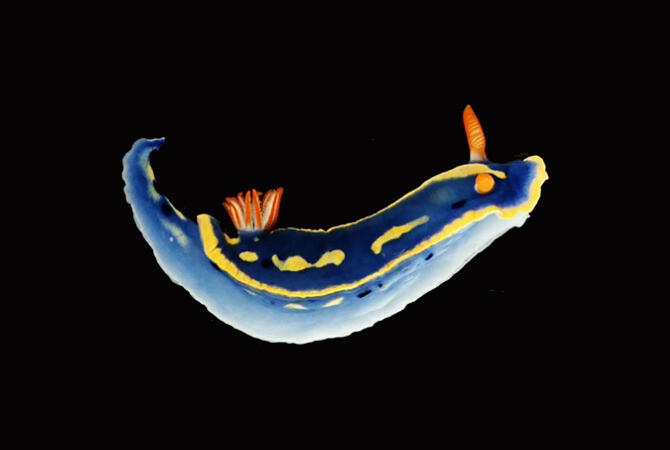Associate Professor Hiroaki Nakano of the Shimoda Marine Research Center and Makiko Hayashi, a third-year doctoral student of the Doctoral Program in Biology, Degree Programs in Life and Earth Sciences at the University of Tsukuba, successfully reared Hypselodoris festiva from eggs to adults in the laboratory and observed the process of larval settlement, metamorphosis into juveniles, and growth of the juveniles. This is the world's first study on successful laboratory rearing of a Chromodorididae species from larvae to adults. This work was published in Scientific Reports.

Provided by the Shimoda Marine Research Center (SMRC), University of Tsukuba
Nudibranchs are marine snails of the class Gastropoda within the phylum Mollusca, and their shells are either degenerated or lost. Nudibranchs belonging to the family Chromodorididae are characterized by their brightly colored bodies and include the familiar sea slugs found on rocky shores, such as Hypselodoris festiva and Chromodoris orientalis. Adults are found crawling on reefs and feeding on sponges, whereas newly hatched larvae drift in the sea and grow by feeding on phytoplankton. Larvae and juveniles, which are individuals that have undergone settlement and metamorphosis, are very small. It is difficult to observe the growth process from eggs to adults in field environments. It is also not easy to identify, collect, and maintain the sponge species eaten by nudibranchs. There were no examples of rearing nudibranchs of the family Chromodorididae from eggs to adults in the laboratory. Therefore, the steps involved in the formation of bright body color patterns and major adult organs, which are considered to occur during the post-settlement growth process, were unknown.
The research group collected adult H. festiva individuals, reared them in the laboratory, and made them spawn eggs there. About six days later, thousands of planktonic larvae had hatched from a single egg mass. While the larvae were fed on microalgae for approximately 3 weeks thereafter, the development of eye spots and other features, settlement, and metamorphosis occurred. During metamorphosis, larvae cast off their shells and moved on to the benthic life stage.
Juveniles grew by feeding on sponges, which are adult prey. During this process, the formation of bright body color patterns consisting of blue and yellow was completed, and major adult organs, such as the rhinophores, gills, and anus, were formed.
Based on the observed body color formation and organogenesis processes, the post-settlement growth process of H. festiva was categorized into a total of 9 stages, comprising 2 and 7 stages of metamorphosis and juvenile phases, respectively. This categorization allows for identifying the growth stages of H. festiva individuals based on external characteristics. This study provides a benchmark for developmental research in the Chromodorididae family. Although the appropriate rearing conditions for larvae, juveniles, and adults of the Chromodorididae family have previously been unknown, the rearing methods described in this study can be applied to other chromodorid species and are expected to contribute to commercial purposes, such as at aquarium exhibitions.
Journal Information
Publication: Scientific Reports
Title: Staging of post-settlement growth in the nudibranch Hypselodoris festiva
DOI: 10.1038/s41598-024-66322-4
This article has been translated by JST with permission from The Science News Ltd. (https://sci-news.co.jp/). Unauthorized reproduction of the article and photographs is prohibited.




